publications
publications by categories in reversed chronological order. generated by jekyll-scholar.
2024
-
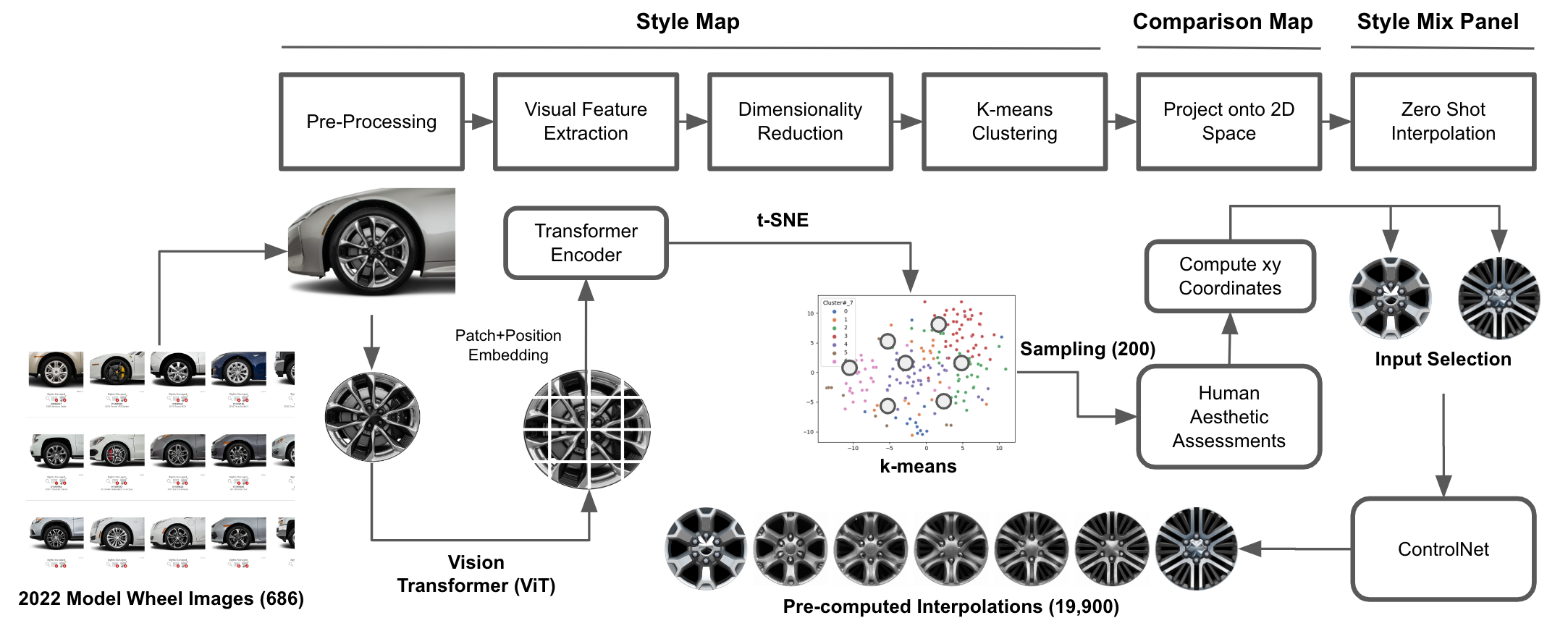 Weaving ML with Human Aesthetic Assessments to Augment Design Space Exploration: An Automotive Wheel Design Case StudyYoungseung Jeon, Matthew K. Hong, Yan-Ying Chen, Kalani Murakami, Jonathan Q. Li, Xiang ’Anthony’ Chen, and Matthew KlenkIn Extended Abstracts of the 2024 CHI Conference on Human Factors in Computing Systems, 2024
Weaving ML with Human Aesthetic Assessments to Augment Design Space Exploration: An Automotive Wheel Design Case StudyYoungseung Jeon, Matthew K. Hong, Yan-Ying Chen, Kalani Murakami, Jonathan Q. Li, Xiang ’Anthony’ Chen, and Matthew KlenkIn Extended Abstracts of the 2024 CHI Conference on Human Factors in Computing Systems, 2024Consumers’ emotional and cognitive attachment to product design plays a pivotal role in influencing purchasing choices. Therefore, product designers incorporate this signal as they develop new products. The goal of our work is to reduce the psychological distance between designers and consumers in the automotive concept design process. While generative AI models hold the potential to amplify creativity, these models do not have any of this specialized knowledge. In this work, we developed a novel framework and system that combines machine learning, human aesthetic assessments, and visualization to support designers in organizing a large space of automotive wheel designs. We present a case study with 10 automotive designers using the tool to inspire novel wheel designs and end with a discussion of use cases and design implications for using this framework to support professional product design practice.
@inproceedings{jeon2024weaving, title = {Weaving ML with Human Aesthetic Assessments to Augment Design Space Exploration: An Automotive Wheel Design Case Study}, author = {Jeon, Youngseung and Hong, Matthew K. and Chen, Yan-Ying and Murakami, Kalani and Li, Jonathan Q. and Chen, Xiang 'Anthony' and Klenk, Matthew}, booktitle = {Extended Abstracts of the 2024 CHI Conference on Human Factors in Computing Systems}, pages = {1--10}, year = {2024} } - Unstuck: Charting the Design Space of Generative AI-based Creativity InterventionsMatthew K. Hong, Pablo Paredes, Shabnam Hakimi, Monica Van, and Matthew KlenkIn Generative AI and HCI Workshop at the ACM CHI 2024 Conference on Human Factors in Computing Systems, 2024
Myriad generative AI (GenAI) products and research prototypes have demonstrated practical applications for amplifying human creativity in various professional activities that span writing, music composition, graphic and product design. While many applications of GenAI for creativity support focus on augmenting or altering human-generated content, these tools do not directly address the core challenge of "being stuck", a phenomenon that hinders creatives’ ability to generate original content. In this position paper, we offer broader perspective on the concept of "being stuck" and insights into how GenAI can be leveraged to overcome barriers in the creative process. More specifically, we draw from the HCI and Cognitive Science literature to provide a nuanced conceptualization of stuckness and use this to propose a design space of GenAI-based interventions toward unleashing the potential of creative professionals.
@inproceedings{hong2024unstuck, title = {Unstuck: Charting the Design Space of Generative AI-based Creativity Interventions}, author = {Hong, Matthew K. and Paredes, Pablo and Hakimi, Shabnam and Van, Monica and Klenk, Matthew}, booktitle = {Generative AI and HCI Workshop at the ACM CHI 2024 Conference on Human Factors in Computing Systems}, year = {2024} } -
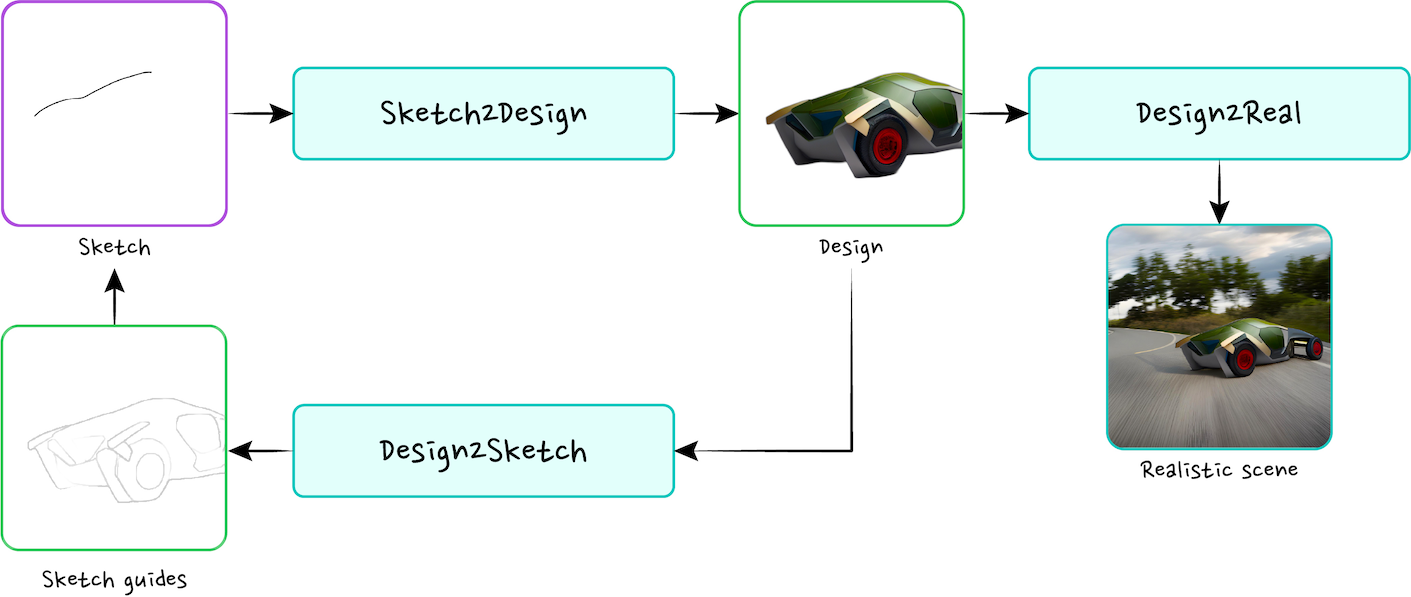 Supporting Designers to Prototype Product Designs through SketchingDavid Chuan-En Lin, Hyeonsu B. Kang, Nikolas Martelaro, Aniket Kittur, Yan-Ying Chen, and Matthew K. HongIn Generative AI and HCI Workshop at the ACM CHI 2024 Conference on Human Factors in Computing Systems, 2024
Supporting Designers to Prototype Product Designs through SketchingDavid Chuan-En Lin, Hyeonsu B. Kang, Nikolas Martelaro, Aniket Kittur, Yan-Ying Chen, and Matthew K. HongIn Generative AI and HCI Workshop at the ACM CHI 2024 Conference on Human Factors in Computing Systems, 2024With recent advancements in the capabilities of text-to-image (T2I) AI models, designers have begun experimenting with them in their work. However, through conversations with designers, we have identified several key challenges. First, designers often begin with a project with an abstract theme, yet T2I models struggle to interpret it. Second, designers find it difficult to iterate on generated designs. T2I models feel like slot machines, rather than tools for iterative design. Third, designers would like to create visual presentations of their designs in realistic scenes to effectively communicate with stakeholders. To address these challenges, we developed Inkspire, a sketch-driven system for designers to create product designs. Inkspire helps designers brainstorm design inspirations with Large Language Models (LLMs), generate product designs by drawing simple sketch strokes on a canvas, convert generated designs into sketches for inspiration and rapid iteration, and visualize designs in realistic settings. This paper introduces the Inkspire system.
@inproceedings{lin2024inkspire, title = {Supporting Designers to Prototype Product Designs through Sketching}, author = {Lin, David Chuan-En and Kang, Hyeonsu B. and Martelaro, Nikolas and Kittur, Aniket and Chen, Yan-Ying and Hong, Matthew K.}, booktitle = {Generative AI and HCI Workshop at the ACM CHI 2024 Conference on Human Factors in Computing Systems}, year = {2024} } -
 BioSpark: An End-to-End Generative System for Biological-Analogical Inspirations and IdeationHyeonsu B. Kang, David Chuan-en Lin, Martelaro Nikolas, Aniket Kittur, Yan-Ying Chen, and Matthew K. HongIn Extended Abstracts of the 2024 CHI Conference on Human Factors in Computing Systems, 2024
BioSpark: An End-to-End Generative System for Biological-Analogical Inspirations and IdeationHyeonsu B. Kang, David Chuan-en Lin, Martelaro Nikolas, Aniket Kittur, Yan-Ying Chen, and Matthew K. HongIn Extended Abstracts of the 2024 CHI Conference on Human Factors in Computing Systems, 2024Nature often inspires solutions for complex engineering problems, but it is challenging for designers to discover relevant analogies and synthesize from them. Here, we present an end-to-end system, BioSpark, that generates biological-analogical mechanisms and provides an interactive interface for comprehension and ideation. From a small seed set of expert-curated mechanisms, BioSpark’s pipeline iteratively expands them by constructing and traversing organism taxonomies, aiming to overcome both data sparsity in ex- pert curation and limited conceptual diversity in purely automated analogy generation. The interface helps designers recognize and un- derstand relevant analogs to design problems using four interaction features. We conduct an exploratory study with design students to showcase how BioSpark facilitated analogical transfer of ideas but was limited in conveying active ingredients, the core abstraction underpinning how mechanisms work. We discuss this limitation and other implications such as generative hallucination that could facilitate shifts in human exploration of new design spaces.
@inproceedings{kang2024biospark, title = {BioSpark: An End-to-End Generative System for Biological-Analogical Inspirations and Ideation}, author = {Kang, Hyeonsu B. and Lin, David Chuan-en and Nikolas, Martelaro and Kittur, Aniket and Chen, Yan-Ying and Hong, Matthew K.}, booktitle = {Extended Abstracts of the 2024 CHI Conference on Human Factors in Computing Systems}, pages = {1--13}, year = {2024} }
2023
- Generative AI for Product Design: Getting the Right Design and the Design RightMatthew K. Hong, Shabnam Hakimi, Yan-Ying Chen, Heishiro Toyoda, Charlene Wu, and Matthew KlenkIn arXiv preprint arXiv:2306.01217, 2023
Generative AI (GenAI) models excel in their ability to recognize patterns in existing data and generate new and unexpected content. Recent advances have motivated applications of GenAI tools (e.g., Stable Diffusion, ChatGPT) to professional practice across industries, including product design. While these generative capabilities may seem enticing on the surface, certain barriers limit their practical application for real-world use in industry settings. In this position paper, we articulate and situate these barriers within two phases of the product design process, namely "getting the right design" and "getting the design right," and propose a research agenda to stimulate discussions around opportunities for realizing the full potential of GenAI tools in product design.
@inproceedings{hong2023generative, title = {Generative AI for Product Design: Getting the Right Design and the Design Right}, author = {Hong, Matthew K. and Hakimi, Shabnam and Chen, Yan-Ying and Toyoda, Heishiro and Wu, Charlene and Klenk, Matthew}, booktitle = {arXiv preprint arXiv:2306.01217}, pages = {1--3}, year = {2023} } -
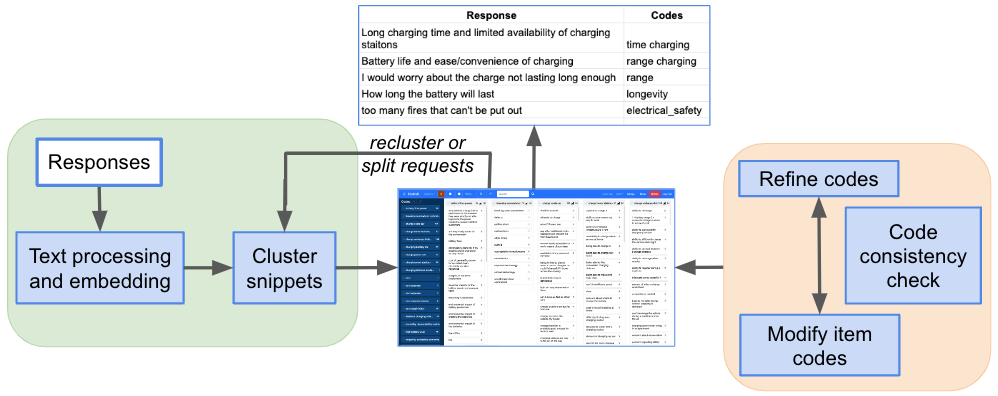 CodeML: A Machine Learning-Assisted User Interface for Code Identification and LabelingFrancine Chen, Matthew K Hong, Laurent Denoue, Kate Glazko, Emily Sarah Sumner, Yan-Ying Chen, and Matthew KlenkIn Extended Abstracts of the 2023 CHI Conference on Human Factors in Computing Systems, 2023
CodeML: A Machine Learning-Assisted User Interface for Code Identification and LabelingFrancine Chen, Matthew K Hong, Laurent Denoue, Kate Glazko, Emily Sarah Sumner, Yan-Ying Chen, and Matthew KlenkIn Extended Abstracts of the 2023 CHI Conference on Human Factors in Computing Systems, 2023Labeling short, unstructured texts is generally performed by sequentially identifying codes and assigning them to segments of text based on viewing a small sample of data. In this greedy approach, coders risk overlooking important code ideas and must perform the tedious task of iteratively revising the initial code set, and sometimes response code assignments, as new themes emerge. To address this, we propose CodeML, a machine learning-assisted (ML) coding interface that identifies multiple ideas in a response, which are displayed to support interactive data exploration, code identification, and refinement of snippet code assignments. By surfacing themes and snippets early, coders can consider a broader range of potential codes to reduce chances of omitting codes that surface later. A comparative study against search-style coding shows the potential for CodeML to facilitate initial exploration and discovery of finer-grained code sets while not adding significant cognitive load to organize codes and underlying text snippets.
title = {CodeML: A Machine Learning-Assisted User Interface for Code Identification and Labeling}, author = {Chen, Francine and Hong, Matthew K and Denoue, Laurent and Glazko, Kate and Sumner, Emily Sarah and Chen, Yan-Ying and Klenk, Matthew}, booktitle = {Extended Abstracts of the 2023 CHI Conference on Human Factors in Computing Systems}, pages = {1--7}, year = {2023} } -
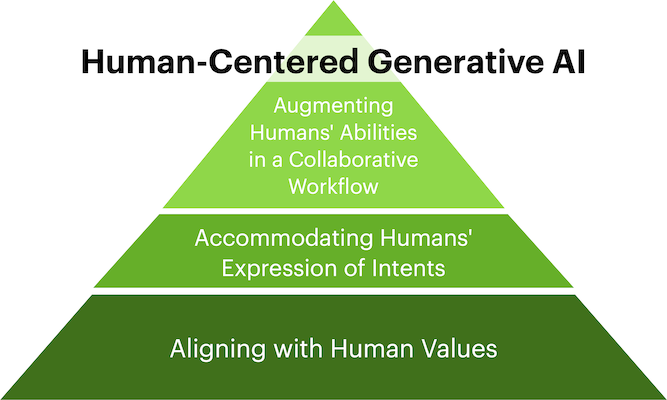 Next Steps for Human-Centered Generative AI: A Technical PerspectiveXiang ’Anthony’ Chen, Jeff Burke, Ruofei Du, Matthew K. Hong, Jennifer Jacobs, Philippe Laban, Dingzeyu Li, Nanyun Peng, Karl D. D. Willis, Chien-Sheng Wu, and othersarXiv preprint arXiv:2306.15774, 2023
Next Steps for Human-Centered Generative AI: A Technical PerspectiveXiang ’Anthony’ Chen, Jeff Burke, Ruofei Du, Matthew K. Hong, Jennifer Jacobs, Philippe Laban, Dingzeyu Li, Nanyun Peng, Karl D. D. Willis, Chien-Sheng Wu, and othersarXiv preprint arXiv:2306.15774, 2023Through iterative, cross-disciplinary discussions, we define and propose next-steps for Human-centered Generative AI (HGAI) from a technical perspective. We contribute a roadmap that lays out future directions of Generative AI spanning three levels: Aligning with human values; Accommodating humans’ expression of intents; and Augmenting humans’ abilities in a collaborative workflow. This roadmap intends to draw interdisciplinary research teams to a comprehensive list of emergent ideas in HGAI, identifying their interested topics while maintaining a coherent big picture of the future work landscape.
@article{chen2023next, title = {Next Steps for Human-Centered Generative AI: A Technical Perspective}, author = {Chen, Xiang 'Anthony' and Burke, Jeff and Du, Ruofei and Hong, Matthew K. and Jacobs, Jennifer and Laban, Philippe and Li, Dingzeyu and Peng, Nanyun and Willis, Karl D. D. and Wu, Chien-Sheng and others}, journal = {arXiv preprint arXiv:2306.15774}, pages = {1--34}, year = {2023} } -
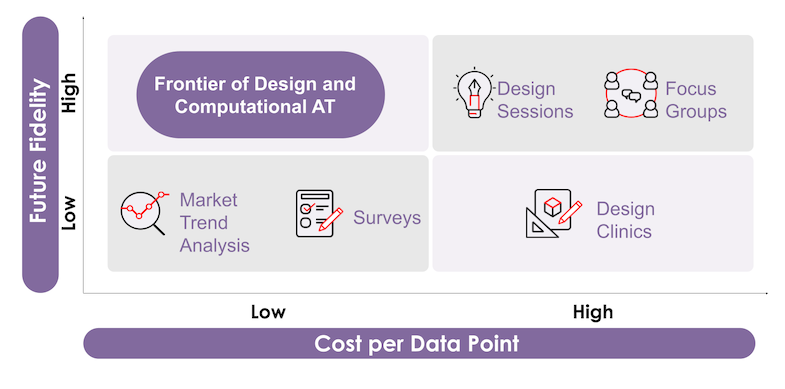 Anticipatory thinking in designMatthew Klenk, Matthew Hong, Shabnam Hakimi, and Charlene WuAI Magazine, 2023
Anticipatory thinking in designMatthew Klenk, Matthew Hong, Shabnam Hakimi, and Charlene WuAI Magazine, 2023Anticipatory thinking (AT) and design have many commonalities. We identify three challenges for all computational AT systems: representation, generation, and evaluation. We discuss how existing artificial intelligence techniques provide some methods for addressing these, but also fall significantly short. Next, we articulate where AT concepts appear in three computational design paradigms: configuration design, design for resilience, and conceptual design. We close by identifying two promising future directions at the intersection of AT and design: modeling other humans and new interfaces to support human decision‐makers.
@article{klenk2023anticipatory, title = {Anticipatory thinking in design}, author = {Klenk, Matthew and Hong, Matthew and Hakimi, Shabnam and Wu, Charlene}, journal = {AI Magazine}, volume = {44}, number = {2}, pages = {165--172}, year = {2023} } -
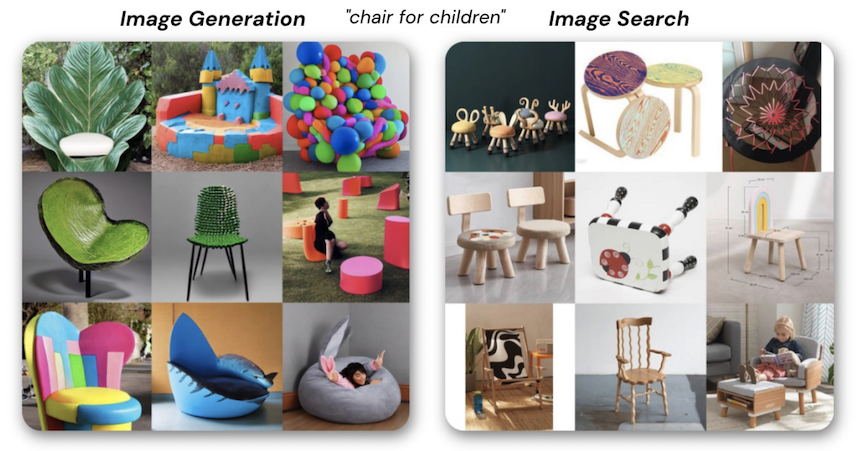 DesignAID: Using Generative AI and Semantic Diversity for Design InspirationAlice Cai, Steven R Rick, Jennifer L Heyman, Yanxia Zhang, Alexandre Filipowicz, Matthew Hong, Matthew Klenk, and Thomas MaloneIn Proceedings of The ACM Collective Intelligence Conference, 2023
DesignAID: Using Generative AI and Semantic Diversity for Design InspirationAlice Cai, Steven R Rick, Jennifer L Heyman, Yanxia Zhang, Alexandre Filipowicz, Matthew Hong, Matthew Klenk, and Thomas MaloneIn Proceedings of The ACM Collective Intelligence Conference, 2023Designers often struggle to sufficiently explore large design spaces, which can lead to design fixation and suboptimal outcomes. Here we introduce DesignAID, a generative AI tool that supports broader design space exploration by first using large language models to produce a range of diverse ideas expressed in words, and then using image generation software to create images from these words. This innovative combination of AI-based capabilities allows human-computer pairs to rapidly create a diverse set of visual concepts without time-consuming drawing. In a study with 87 crowd-sourced designers, we found that designers rated the automatic generation of images from words as significantly more inspirational, enjoyable, and useful than a conventional baseline condition of image search using Pinterest. Surprisingly, however, we found that automatically generating highly diverse ideas had less value. For image generation, the high diversity condition was somewhat better in inspiration but no better in the other dimensions, and for image search it was significantly worse in all dimensions.
@inproceedings{cai2023designaid, title = {DesignAID: Using Generative AI and Semantic Diversity for Design Inspiration}, author = {Cai, Alice and Rick, Steven R and Heyman, Jennifer L and Zhang, Yanxia and Filipowicz, Alexandre and Hong, Matthew and Klenk, Matthew and Malone, Thomas}, booktitle = {Proceedings of The ACM Collective Intelligence Conference}, pages = {1--11}, year = {2023} } -
 BIOSPARK: An End-to-end Generative System for Biological-Analogical Inspirations and IdeationHyeonsu B. Kang, David Chuan-en Lin, Martelaro Nikolas, Aniket Kittur, Yan-Ying Chen, and Matthew K. HongIn Machine Learning for Creativity and Design Workshop at NeurIPS 2023, 2023
BIOSPARK: An End-to-end Generative System for Biological-Analogical Inspirations and IdeationHyeonsu B. Kang, David Chuan-en Lin, Martelaro Nikolas, Aniket Kittur, Yan-Ying Chen, and Matthew K. HongIn Machine Learning for Creativity and Design Workshop at NeurIPS 2023, 2023Nature provides a valuable source of inspirations for novel design solutions to challenging engineering problems. Yet, achieving the full potential of biological-analogical inspirations in engineering and design domains has proven difficult due to the difficulty of discovering relevant analogies and sufficiently understanding them to synthesize novel insights. Here, we introduce an end-to-end system that combines a scalable pipeline for generating biological-analogical mechanisms from nature and an interactive interface that facilitates users’ understanding and synthesis with them. Our dataset generation pipeline starts from a small seed mechanism from human experts and expands it using breadth- and depth-focused expansion prompts based on iteratively constructed taxonomic hierarchies. This approach mitigates the sparsity of data due to high cost of expert curation and the limited conceptual diversity in automated analogy generation using Large Language Models (LLMs). Furthermore, the interactive interface assists designers in recognizing and understanding the applicability of analogs to design problems through four interaction features: Explain, Compare, Combine, and Critique. Our case studies showcase the potential value of our system. We end with avenues for future research.
@inproceedings{kang2023biospark, title = {BIOSPARK: An End-to-end Generative System for Biological-Analogical Inspirations and Ideation}, author = {Kang, Hyeonsu B. and Lin, David Chuan-en and Nikolas, Martelaro and Kittur, Aniket and Chen, Yan-Ying and Hong, Matthew K.}, booktitle = {Machine Learning for Creativity and Design Workshop at NeurIPS 2023}, year = {2023} } -
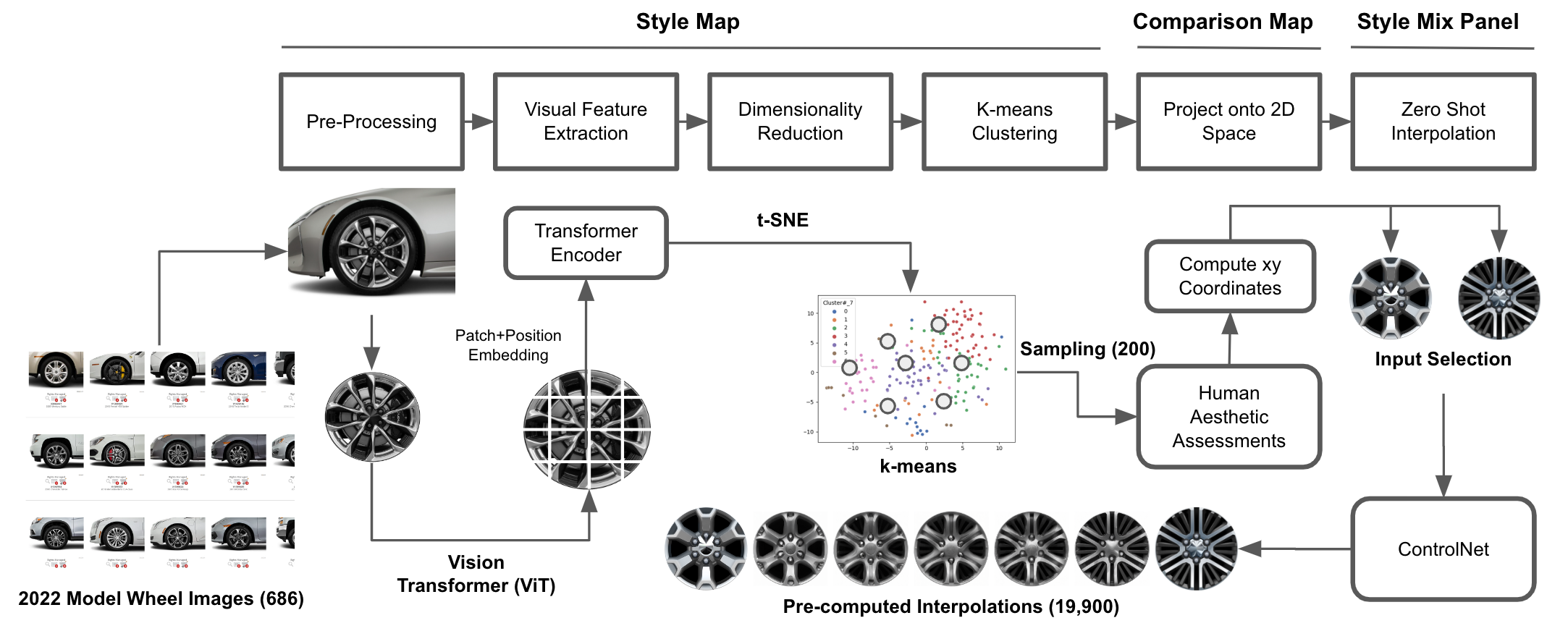 Weaving ML with Human Aesthetic Assessments to Augment Design Space ExplorationYoungseung Jeon, Matthew K. Hong, Yan-Ying Chen, Kalani Murakami, Jonathan Q. Li, Xiang ’Anthony’ Chen, and Matthew KlenkIn Machine Learning for Creativity and Design Workshop at NeurIPS 2023, 2023
Weaving ML with Human Aesthetic Assessments to Augment Design Space ExplorationYoungseung Jeon, Matthew K. Hong, Yan-Ying Chen, Kalani Murakami, Jonathan Q. Li, Xiang ’Anthony’ Chen, and Matthew KlenkIn Machine Learning for Creativity and Design Workshop at NeurIPS 2023, 2023People’s semantic connection with product design is an important signal that drives purchase decisions and overall satisfaction. In the concept design phase, capturing and responding to this signal is an important part of a product designer’s job. Yet in automotive design, where online experimentation is not a viable option, this process is driven by speculation about consumers’ aesthetic preferences, drawing from designers’ intuition, prior experience, and domain knowledge. Our goal is to reduce the psychological distance between designers and consumers in the automotive concept design process and address potential biases (e.g., design fixation) that could emerge from it. In this work, we developed a novel framework and system that combines machine learning, human aesthetic assessments, and interface design to support designers in organizing a large space of automotive wheel designs. We hope our demo can stimulate discussions around using this framework for professional product design practice.
@inproceedings{jeon2023weaving, title = {Weaving ML with Human Aesthetic Assessments to Augment Design Space Exploration}, author = {Jeon, Youngseung and Hong, Matthew K. and Chen, Yan-Ying and Murakami, Kalani and Li, Jonathan Q. and Chen, Xiang 'Anthony' and Klenk, Matthew}, booktitle = {Machine Learning for Creativity and Design Workshop at NeurIPS 2023}, year = {2023} }
2022
- Supporting Qualitative Coding with Machine-in-the-loopMatthew K. Hong, Francine Chen, Yan-Ying Chen, and Matthew KlenkIn Human-Centered AI Workshop at NeurIPS 2022, 2022
title = {Supporting Qualitative Coding with Machine-in-the-loop}, author = {Hong, Matthew K. and Chen, Francine and Chen, Yan-Ying and Klenk, Matthew}, booktitle = {Human-Centered AI Workshop at NeurIPS 2022}, year = {2022} }
2021
-
 Planning for Natural Language Failures with the AI PlaybookMatthew K Hong, Adam Fourney, Derek DeBellis, and Saleema AmershiIn Proceedings of the 2021 CHI Conference on Human Factors in Computing Systems, 2021
Planning for Natural Language Failures with the AI PlaybookMatthew K Hong, Adam Fourney, Derek DeBellis, and Saleema AmershiIn Proceedings of the 2021 CHI Conference on Human Factors in Computing Systems, 2021Prototyping AI user experiences is challenging due in part to probabilistic AI models making it difficult to anticipate, test, and mitigate AI failures before deployment. In this work, we set out to support practitioners with early AI prototyping, with a focus on natural language (NL)-based technologies. Our interviews with 12 NL practitioners from a large technology company revealed that, in addition to challenges prototyping AI, prototyping was often not happening at all or focused only on idealized scenarios due to a lack of tools and tight timelines. These findings informed our design of the AI Playbook, an interactive and low-cost tool we developed to encourage proactive and systematic consideration of AI errors before deployment. Our evaluation of the AI Playbook demonstrates its potential to 1) encourage product teams to prioritize both ideal and failure scenarios, 2) standardize the articulation of AI failures from a user experience perspective, and 3) act as a boundary object between user experience designers, data scientists, and engineers.
@inproceedings{hong2021planning, title = {Planning for Natural Language Failures with the AI Playbook}, author = {Hong, Matthew K and Fourney, Adam and DeBellis, Derek and Amershi, Saleema}, booktitle = {Proceedings of the 2021 CHI Conference on Human Factors in Computing Systems}, year = {2021} }
2020
- Using Diaries to Probe the Illness Experiences of Adolescent Patients and Parental CaregiversMatthew K Hong, Udaya Lakshmi, Kimberly Do, Sampath Prahalad, Thomas Olson, Rosa I Arriaga, and Lauren WilcoxIn Proceedings of the 2020 CHI Conference on Human Factors in Computing Systems, 2020
Adolescents with chronic conditions must work with family caregivers to manage their illness experiences. To explore how technology can support collaborative documentation of these experiences, we designed and distributed a paper diary probe kit in a two-week field deployment with 12 adolescent-parent dyads (24 participants). Three insights emerged from the study that highlight how technology can support shared illness management: 1) provide scaffolds to recognize physical and emotional experiences in the context of daily activities; 2) help families reconstruct patient experiences; and 3) adapt to individual preferences for capturing, representing and sharing experiences. We discuss opportunities for HCI research that follow from these findings and conclude by reflecting on the benefits and limitations of using diary probes with adolescent patients and their parental caregivers.
@inproceedings{hong2020using, title = {Using Diaries to Probe the Illness Experiences of Adolescent Patients and Parental Caregivers}, author = {Hong, Matthew K and Lakshmi, Udaya and Do, Kimberly and Prahalad, Sampath and Olson, Thomas and Arriaga, Rosa I and Wilcox, Lauren}, booktitle = {Proceedings of the 2020 CHI Conference on Human Factors in Computing Systems}, pages = {1--16}, year = {2020} }
2019
- Designing Visual Communication of Everyday Illness Experiences in Pediatric CareMatthew K HongIn Extended Abstracts of the 2019 CHI Conference on Human Factors in Computing Systems, 2019
In complex chronic care, patients’ ongoing awareness of their health status and ability to articulate health needs are vital to active participation in care, yet they face various challenges that could thwart their potential to engage in such participation. My research explores how design methods in HCI can evolve to meet these challenges by engaging both adolescents and family caregivers throughout the process of tracking the patients’ illness experiences and co-designing rich representations that are expected to support adolescents’ communication of these experiences in care. This thesis will contribute 1) a critical understanding of the ways in which human-centered design can address primary challenges that adolescents face when engaging in care, 2) a novel method for conducting co-design research with chronically ill patient families, and a 3) family-centered mobile health technology that demonstrates the feasibility of engaging pediatric patient families.
@inproceedings{hong2019designing, title = {Designing Visual Communication of Everyday Illness Experiences in Pediatric Care}, author = {Hong, Matthew K}, booktitle = {Extended Abstracts of the 2019 CHI Conference on Human Factors in Computing Systems}, pages = {1--5}, year = {2019} }
2018
- Visual ODLs: Co-Designing Patient-Generated Observations of Daily Living to Support Data-Driven Conversations in Pediatric Care.Matthew K. Hong, Udaya Lakshmi, Thomas A. Olson, and Lauren WilcoxIn Proceedings of the 36th Annual ACM Conference on Human Factors in Computing Systems (CHI 2018), 2018
Teens with complex chronic illnesses have difficulty understanding and articulating symptoms such as pain and emotional distress. Yet, symptom communication plays a central role in clinical care and illness management. To understand how design can help overcome these challenges, we created a visual library of 72 sketched illustrations, informed by the Observations of Daily Living framework along with insights from 11 clinician interviews. We utilized our library with storyboarding techniques, free-form sketching, and interviews, in co-design sessions with 13 pairs of chronically-ill teens and their parents. We found that teens depicted symptoms as being interwoven with narratives of personal and social identity. Teens and parents were enthusiastic about collaboratively-generated, interactive storyboards as a tracking and communication mechanism, and suggested three ways in which they could aid in communication and coordination with informal and formal caregivers. In this paper, we detail these findings, to guide the design of tools for symptom-tracking and incorporation of patient-generated data into pediatric care.
@inproceedings{hong2018visual, title = {Visual ODLs: Co-Designing Patient-Generated Observations of Daily Living to Support Data-Driven Conversations in Pediatric Care.}, author = {Hong, Matthew K. and Lakshmi, Udaya and Olson, Thomas A. and Wilcox, Lauren}, booktitle = {Proceedings of the 36th Annual ACM Conference on Human Factors in Computing Systems (CHI 2018)}, year = {2018} } - Variability in adolescent portal privacy features: how the unique privacy needs of the adolescent patient create a complex decision-making processMarianne Sharko, Lauren Wilcox, Matthew K Hong, and Jessica S AnckerJournal of the American Medical Informatics Association, 2018
@article{sharko2018variability, title = {Variability in adolescent portal privacy features: how the unique privacy needs of the adolescent patient create a complex decision-making process}, author = {Sharko, Marianne and Wilcox, Lauren and Hong, Matthew K and Ancker, Jessica S}, journal = {Journal of the American Medical Informatics Association}, volume = {25}, number = {8}, pages = {1008--1017}, year = {2018}, publisher = {Oxford University Press} } - Integrating patient-generated observations of daily living into pediatric cancer care: a formative user interface design studyUdaya Lakshmi, Matthew Hong, and Lauren WilcoxIn 2018 IEEE International Conference on Healthcare Informatics (ICHI), 2018
Patient-generated data, such as recorded Observations of Daily Living (ODL) and Patient-Reported Outcomes (PRO) data, are valued sources of information in oncology care. However, prior work largely focuses on capturing clinician-defined, patient-generated data in adult oncology care. Emerging research at the intersection of human–computer interaction and medical informatics suggests that visual narratives of patients’ observations of daily living (Visual ODLs) could better support multi-party review of patients’ everyday symptoms and quality of life, potentially improving patient–clinician communication. In this paper, we build on a prior study of Visual ODLs by describing a formative, two-phase study with 15 pediatric oncology clinicians. In Phase I, we analyzed data from ethnographic interviews in a pediatric oncology setting to capture the needs of nurses, nurse practitioners, and oncologists. In Phase II, we constructed two low-fidelity dashboard display prototypes, populated with Visual ODLs contributed by actual adolescent oncology patients, and we subsequently interviewed pediatric oncology clinicians who re-viewed each dashboard design. Findings from our study contribute four key design objectives for presenting interactive Visual ODL dashboards in pediatric oncology, along with three use cases for using these dashboards for symptom tracking and communication.
@inproceedings{lakshmi2018integrating, title = {Integrating patient-generated observations of daily living into pediatric cancer care: a formative user interface design study}, author = {Lakshmi, Udaya and Hong, Matthew and Wilcox, Lauren}, booktitle = {2018 IEEE International Conference on Healthcare Informatics (ICHI)}, pages = {265--275}, year = {2018}, organization = {IEEE} } - The need for guidance and consistency in adolescent privacy policies: a survey of CMIOsLauren Wilcox, Marianne Sharko, Matthew K Hong, Julie Hollberg, and Jessica S AckerIn Proceedings of the American Medical Informatics Association Annual Symposium (AMIA 2018), 2018
Research examining whether and how adolescent patients should gain access to their electronic health records is gaining momentum. We conducted a survey to explore diversity in adolescent privacy policies and identify common approaches in health information technology management for adolescent patients. Through descriptive analyses of survey data, we found a wide range of institutional policies regarding adolescent patient privacy, and large variations in health IT executives’ baseline knowledge of access policies. A majority of respondents agreed that formal guidelines pertaining to adolescent health record privacy would be helpful. Respondents suggested that these guidelines can be developed through the synthesis of multiple perspectives, including those of pediatricians, adolescent specialists, privacy experts, parents, patient advocates, and other professional entities.
@inproceedings{wilcox2018need, title = {The need for guidance and consistency in adolescent privacy policies: a survey of CMIOs}, author = {Wilcox, Lauren and Sharko, Marianne and Hong, Matthew K and Hollberg, Julie and Acker, Jessica S}, booktitle = {Proceedings of the American Medical Informatics Association Annual Symposium (AMIA 2018)}, year = {2018} } - Should parents see their teen’s medical record? Asking about the effect on adolescent–doctor communication changes attitudesJessica S Ancker, Marriane Sharko, Matthew K. Hong, Hannah Mitchell, and Lauren WilcoxJournal of the American Medical Informatics Association, 2018
@article{ancker2018should, title = {Should parents see their teen’s medical record? Asking about the effect on adolescent--doctor communication changes attitudes}, author = {Ancker, Jessica S and Sharko, Marriane and Hong, Matthew K. and Mitchell, Hannah and Wilcox, Lauren}, journal = {Journal of the American Medical Informatics Association}, year = {2018} }
2017
- Supporting Families in Reviewing and Communicating about Radiology Imaging StudiesMatthew K. Hong, Clayton Feustel, Meeshu Agnihotri, Max Silverman, Stephen Simoneaux, and Lauren WilcoxIn Proceedings of the 35th Annual ACM Conference on Human Factors in Computing Systems (CHI 2017), 2017
Diagnostic radiology reports are increasingly being made available to patients and their family members. However, these reports are not typically comprehensible to lay recipients, impeding effective communication about report findings. In this paper, we present three studies informing the design of a prototype to foster patient-clinician communication about radiology report content. First, analysis of questions posted in online health forums helped us identify patients’ information needs. Findings from an elicitation study with seven radiologists provided necessary domain knowledge to guide prototype design. Finally, a clinical field study with 14 pediatric patients, their parents and clinicians, revealed positive responses of each stakeholder when using the prototype to interact with and discuss the patient’s current CT or MRI report and allowed us to distill three use cases: co-located communication, preparing for the consultation, and reviewing radiology data. We draw on our findings to discuss design considerations for supporting each of these use cases.
title = {Supporting Families in Reviewing and Communicating about Radiology Imaging Studies}, author = {Hong, Matthew K. and Feustel, Clayton and Agnihotri, Meeshu and Silverman, Max and Simoneaux, Stephen and Wilcox, Lauren}, booktitle = {Proceedings of the 35th Annual ACM Conference on Human Factors in Computing Systems (CHI 2017)}, pages = {5245--5256}, year = {2017}, organization = {ACM} } - Scalable Image-based Search-and-DiscoveryEunji Chong, Jaehoon Lee, Matthew K. Hong, and James M. RehgIn Proceedings of the 2017 CHI Conference Extended Abstracts on Human Factors in Computing Systems, 2017
People use online search-and-discovery services, such as Yelp, by first finding a specific item with keywords and then examining the images linked to the item. Images could constitute an important part of users’ decision-making process but users reach them indirectly. Although recently researchers proposed several image-based search interfaces, how they can effectively arrange huge number of images in a scalable manner is still not clear. To address this, we introduce PicNav, an image-driven navigation system that automatically arranges photos according to their semantic similarity. PicNav is built on deep neural networks learned from the Yelp food dataset and enables effective zoom-in/out features. We conducted interviews with ten users to qualitatively assess the system’s usability. The users identified a number of advantages of PicNav, providing insights into the general use of imagery in search-and-discovery services.
@inproceedings{chong2017scalable, title = {Scalable Image-based Search-and-Discovery}, author = {Chong, Eunji and Lee, Jaehoon and Hong, Matthew K. and Rehg, James M.}, booktitle = {Proceedings of the 2017 CHI Conference Extended Abstracts on Human Factors in Computing Systems}, pages = {1539--1545}, year = {2017}, organization = {ACM} } - The Variation in Patient Portal Access for Adolescents in the United States: How Different Medical Centers Manage their Adolescent Access.Marianne Sharko, Lauren Wilcox, Matthew K Hong, and Jessica S AnckerIn Proceedings of the American Medical Informatics Association Annual Symposium (AMIA 2017), 2017
@inproceedings{sharko2017variation, title = {The Variation in Patient Portal Access for Adolescents in the United States: How Different Medical Centers Manage their Adolescent Access.}, author = {Sharko, Marianne and Wilcox, Lauren and Hong, Matthew K and Ancker, Jessica S}, booktitle = {Proceedings of the American Medical Informatics Association Annual Symposium (AMIA 2017)}, year = {2017} } - Just-in-Time Design: In Situ Methods for Capturing and Articulating Adolescents’ Illness ExperiencesMatthew K Hong, Udaya Lakshmi, and Lauren WilcoxIn Workshop on Interactive Systems in Healthcare, 2017
During phases of treatment and between visits to the doctor’s office, adolescent patients with complex chronic illnesses must recognize and communicate about illness-related experiences with a variety of caregivers. However, significant gaps exist in our understanding of how to design appropriate techniques for eliciting day-to-day, illness- related observations from these patients. To address this gap, we draw on qualitative research on the needs of adolescents with complex chronic illnesses to propose a new, in situ approach to eliciting participatory design input, called “Just-in-Time Design.” Our approach draws inspiration from future breaching experiments and just-in-time intervention research, to both elicit adolescents’ momentary experiences and couple these with participatory design feedback. In this position paper we discuss our work-in-progress including how we are currently applying Just-in-Time Design to design new symptom-tracking tools for adolescents with cancer and chronic blood disorders.
@inproceedings{hong2017just, title = {Just-in-Time Design: In Situ Methods for Capturing and Articulating Adolescents’ Illness Experiences}, author = {Hong, Matthew K and Lakshmi, Udaya and Wilcox, Lauren}, booktitle = {Workshop on Interactive Systems in Healthcare}, year = {2017} }
2016
- Adolescent and Caregiver use of a Tethered Personal Health Record SystemMatthew K. Hong, Lauren Wilcox, Clayton Feustel, Karen Wasileski-Masker, Thomas Olson, and Stephen SimoneauxIn Proceedings of the American Medical Informatics Association Annual Symposium (AMIA 2016), 2016
Supporting adolescent patient engagement in care is an important yet underexplored topic in consumer health informatics. Personal Health Records (PHRs) show potential, but designing PHR systems to accommodate both emerging adults and their parents is challenging. We conducted a mixed-methods study with teenage adolescent patients (ages 13-17) with cancer and blood disorders, and their parents, to investigate their experiences with My-Chart, a tethered PHR system. Through analyses of usage logs and independently-conducted surveys and interviews, we found that patients and parents both valued MyChart, but had different views about the role of the PHR for care communication and management, and different attitudes about its impact on the patient’s ability to manage care. Specific motivations for using MyChart included patient–parent coordination of care activities, communication around hospital encounters, and support for transitioning to adult care. Finally, some parents had concerns about certain diagnostic test results being made available to their children.
@inproceedings{hong2016adolescent, title = {Adolescent and Caregiver use of a Tethered Personal Health Record System}, author = {Hong, Matthew K. and Wilcox, Lauren and Feustel, Clayton and Wasileski-Masker, Karen and Olson, Thomas and Simoneaux, Stephen}, booktitle = {Proceedings of the American Medical Informatics Association Annual Symposium (AMIA 2016)}, pages = {628--637}, year = {2016} } - Care Partnerships: Toward Technology to Support Teens’ Participation in Their Health CareMatthew K. Hong, Lauren Wilcox, Daniel Machado, Thomas A. Olson, and Stephen F. SimoneauxIn Proceedings of the 2016 CHI Conference on Human Factors in Computing Systems, 2016
Adolescents with complex chronic illnesses, such as cancer and blood disorders, must partner with family and clinical caregivers to navigate risky procedures with life-altering implications, burdensome symptoms and lifelong treatments. Yet, there has been little investigation into how technology can support these partnerships. We conducted 38 in-depth interviews (15 with teenage adolescents with chronic forms of cancer and blood disorders, 15 with their parents, and eight with clinical caregivers) along with nine non-participant observations of clinical consultations, to better understand common challenges and needs that could be supported through design. Participants faced challenges primarily concerning: 1) teens’ limited participation in their care, 2) communicating emotionally-sensitive information, and 3) managing physical and emotional responses. We draw on these findings to propose design goals for sociotechnical systems to support teens in partnering in their care, highlighting the need for design to support gradually-evolving partnerships.
@inproceedings{hong2016care, title = {Care Partnerships: Toward Technology to Support Teens' Participation in Their Health Care}, author = {Hong, Matthew K. and Wilcox, Lauren and Machado, Daniel and Olson, Thomas A. and Simoneaux, Stephen F.}, booktitle = {Proceedings of the 2016 CHI Conference on Human Factors in Computing Systems}, pages = {5337--5349}, year = {2016}, organization = {ACM} }
2013
- Schema Builder: A Web-based User Interface for Authoring and Sharing Natural-Language Processing SchemasYang Liu, Melissa Tharp, Matthew K. Hong, Harry Hochheiser, and Wendy W ChapmanIn AMIA, 2013
We present Schema Builder, a web-based user interface to create NLP schemas representing variables to be extracted from clinical text. Schema Builder allows the user to create rich concept-oriented, unambiguous schemas that consist of definitions, linguistic and semantic attributes, synonyms, and mappings to standardized vocabularies. The application assists the user by leveraging a detailed generic NLP schema and providing candidate lists for synonyms, definitions, and concepts from standardized vocabularies. Schemas can be shared among users.
@inproceedings{liu2013schema, title = {Schema Builder: A Web-based User Interface for Authoring and Sharing Natural-Language Processing Schemas}, author = {Liu, Yang and Tharp, Melissa and Hong, Matthew K. and Hochheiser, Harry and Chapman, Wendy W}, booktitle = {AMIA}, year = {2013} }
2012
- Microanalysis of active reading behavior to inform design of interactive desktop workspacesMatthew K. Hong, Anne Marie Piper, Nadir Weibel, Simon Olberding, and James HollanIn Proceedings of the 2012 ACM international conference on Interactive tabletops and surfaces, 2012
We present Schema Builder, a web-based user interface to create NLP schemas representing variables to be extracted from clinical text. Schema Builder allows the user to create rich concept-oriented, unambiguous schemas that consist of definitions, linguistic and semantic attributes, synonyms, and mappings to standardized vocabularies. The application assists the user by leveraging a detailed generic NLP schema and providing candidate lists for synonyms, definitions, and concepts from standardized vocabularies. Schemas can be shared among users.
@inproceedings{hong2012microanalysis, title = {Microanalysis of active reading behavior to inform design of interactive desktop workspaces}, author = {Hong, Matthew K. and Piper, Anne Marie and Weibel, Nadir and Olberding, Simon and Hollan, James}, booktitle = {Proceedings of the 2012 ACM international conference on Interactive tabletops and surfaces}, pages = {215--224}, year = {2012}, organization = {ACM} }